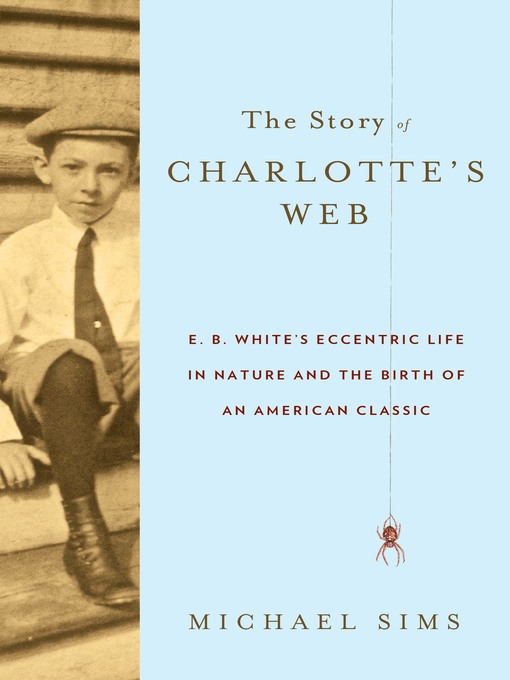
The Story of Charlotte's Web
E. B. White's Eccentric Life in Nature and the Birth of an American Classic
زندگی عجیب و غریب وایت و تولد یک کلاسیک امریکایی
کتاب های مرتبط
- اطلاعات
- نقد و بررسی
- دیدگاه کاربران
نقد و بررسی

August 1, 2011
In this spry biography of Elwyn Brooks White (1899-1985), Sims (Apollo's Fire) immerses himself in White's oeuvre and channels his lucid prose style. Juxtaposing details from White's essays and letters with his own research and sprinkling the text with White's gimlet-eyed quotations, Sims depicts the author (who lived in suburban Mount Vernon and summered in Maine) as a melancholy wunderkind. The deeply sensitive, meticulous Whiteâ"plagued by wild anxieties and indefinable nostalgia" all his lifeâgrew up admiring naturalist writers like Ernest Thompson Seton, and contributing animal stories to St. Nicholas children's magazine. Sims breezes past White's college years, focusing instead on his introversion and romantic-washout status, while also devoting attention to his blossoming as a staff writer and cartoon-captioning whiz for Harold Ross' New Yorker. According to Sims, White drew inspiration from Don Marquis' anthropomorphic cockroach and cat, as well as from wife-to-be Katharine Angell, and fellow writer James Thurber. Not until his 50s, after years in the city and on his small Maine farm, did White utilize these formative influences for Charlotte's Web. Admirers of White's essays and luminous children's literature will be delighted by this amiable chronicle. 8p b&w insert.

April 15, 2011
An affectionate biography examines the birth of an American classic.
As the subtitle indicates, Sims (Apollo's Fire: A Day on Earth in Nature and Imagination, 2007, etc.) concentrates on White's lifelong love of the natural world. He loved the family stable, writes the author, and roamed the undeveloped places in and around Mount Vernon, N.Y., as well as reveling in the rustic beauty of the Belgrade Lakes in Maine, where his family summered. White's reading tastes revolved around the "true life" animal stories of Ernest Thompson Seton and his ilk, and he was also charmed by the antics of Don Marquis' Archy and Mehitabel. White began writing early, first keeping a diary and then joining the child contributors to St. Nicholas, among whom also numbered his future wife, Katharine Sergeant. Sims also traces White's New Yorker career, touching lightly on high points and drawing on his writings, both public and private, in which he often adopted the voices of animals. The author avoids the often-irritating tendency of literary biographers to foreshadow portentously from these early experiences, allowing readers to draw their own connections. His examination of the genesis and development of Charlotte's Web—White worked desperately to nurse an ill pig back to health, knowing that if he was successful, he would end up killing it anyway—will thrill lovers of the novel. Sims quotes generously from White's working drafts, which were constantly in revision from the beginning. Descriptions of these pages offer both a fascinating insight into the writing process and crushing refutation of any claim that writing for children is easy.
Packed with the same kind of sensory detail its subject reveled in, this account is an honorable addition to the literature of letters.
(COPYRIGHT (2011) KIRKUS REVIEWS/NIELSEN BUSINESS MEDIA, INC. ALL RIGHTS RESERVED.)

June 1, 2011
Sims (Adam's Navel: A Natural and Cultural History of the Human Form), as a droll observer of the natural world and editor of the annotated edition of one of E.B. White's formative influences, Don Marquis's Archy and Mehitabel, is uniquely qualified to write what is a biography of Charlotte's Web as much as it's a biography of White. White's childhood fascination with the world's smaller denizens and his literary career, including his storied history at The New Yorker, are traced by Sims to their climax in the germination of the plot for Charlotte's Web. Like Beatrix Potter, whose children's stories about anthropomorphized animals were written a half-century before, White consciously avoided moralizing and instead attempted naturalistic faithfulness. Although his children's books were extremely successful and tourists flocked unbidden to his Maine farm each year for his birthday, he longed for solitude throughout his life and felt the greatest connection with animals; Sims successfully argues that Charlotte's Web unintentionally became a "summary of what it felt like to be E.B. White." VERDICT Scholars of children's literature as well as fans--child and grown-up alike--of either White generally or Charlotte's Web in particular will enjoy this biblio-biography.--Megan Hodge, Randolph-Macon Coll. Lib., Ashland, VA
Copyright 2011 Library Journal, LLC Used with permission.

























دیدگاه کاربران